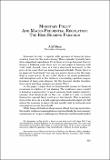Mostrar el registro sencillo del ítem
Monetary policy and macro-prudential regulation: the risk-sharing paradigm
| dc.contributor.author | Mian, Atif R. | |
| dc.date.accessioned | 2019-11-01T00:06:12Z | |
| dc.date.available | 2019-11-01T00:06:12Z | |
| dc.date.issued | 2014 | |
| dc.identifier.isbn | 978-956-7421-45-9 | |
| dc.identifier.uri | https://hdl.handle.net/20.500.12580/3809 | |
| dc.description | Economic history is replete with episodes of financial crises creating havoc for the real economy. These episodes typically have three important ingredients. First there are large financial flows to finance a bubbling asset class such as sovereigns or housing with 'safe' debt. Second there is a sharp downward movement in the price of the asset that was being financed with debt. Third there is no apparent 'real shock' that one can point a figure at for the large drop in asset prices. In particular there is no major productionside disruption such as the failure of a technology political coup or breakout of large-scale disease. Yet the financial shocks translate into a deep and long economic recession. Why? | |
| dc.format | ||
| dc.format.extent | Sección o Parte de un Documento | |
| dc.format.medium | p. 315-330 | |
| dc.language.iso | eng | |
| dc.publisher | Banco Central de Chile | |
| dc.relation.ispartof | Series on Central Banking Analysis and Economic Policies no. 19 | |
| dc.rights | Attribution-NonCommercial-NoDerivs 3.0 Chile | * |
| dc.rights.uri | http://creativecommons.org/licenses/by-nc-nd/3.0/cl/ | * |
| dc.subject | POLÍTICA MONETARIA | es_ES |
| dc.subject | CRISIS FINANCIERA | es_ES |
| dc.title | Monetary policy and macro-prudential regulation: the risk-sharing paradigm | |
| dc.type.doc | Artículo | |
| dc.file.name | BCCh-sbc-v19-p315_330 |


